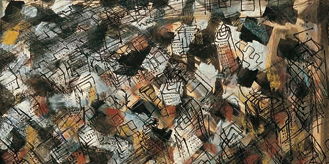
In New York he found himself a dollar room in Stanton Street, in the Bowery, an area of decaying slums, a place of poverty, vice, death and suffering. Congdon sought in that pain the same evil ‘to redeem’ that he had seen in Bergen Belsen. His painting came to feed and depend on such daily experiences (“I courted the marginal, tight-rope life”, he would later say), which like the drama of life and death, always takes on new forms.
Within just three months, Congdon abandoned the squalor of the Bowery for the luxury of Park Avenue, in search of other images. The decaying facades of the Bowery became disturbing urban landscapes, in which black spread like a stain (Explosion) until it came to bury the entire city in his subsequent paintings (the Cities).
At home Congdon’s paintings began to enjoy certain renown. The action painting explosion dominated the New York scene at that time. Demanding complete freedom from the confines of tradition, the action painters dripped or threw color onto canvas, guided by their instincts and subconscious.
In 1949, upon returning from his travels around Italy, Congdon’s fame grew thanks to his meeting with Peggy Guggenheim and Betty Parsons, the art gallery owner who showed the whole new generation of Action Painters, including Pollock, Rothko, Motherwell, and Barnett Newman. His awareness, even pride, at being a fully American artist, emerged from his meeting with the action painters. This awareness never left him during his subsequent years of exile, rather it accentuated his sense of isolation, but also of the originality of his painting in the European context.
However, he had an instinctively defensive reaction in relation to other artists. This led Congdon to distance himself from the action painters. With the passage of time, he became aware that his generation, a victim of its own anger, was destined to suffer a rapid and tragic decline.
Congdon continued on his journey alone. Already by around 1950, while he was distancing himself from the American artistic scene, albeit still exhibiting in the gallery of his friend Betty Parsons, he created his own figurative language using his now mature technique.